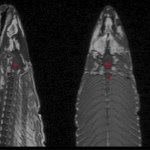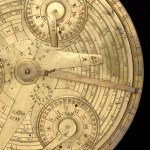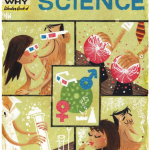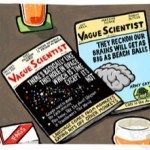Science in Culture & Policy
I've simply got too much to do this week to review these articles with the time and thought they deserve, so I'd just like to point them out to you.
First, Scibling Bora has written a massive critique of "Investigative Science Journalism." It's well worth a read, but set aside some time for it. One of the interesting issues Bora addresses is trust:
Journalists display an inordinate amount of skepticism - even deep cynicism - about anyone's honesty. Everyone's a liar unless proven not to be. Scientists, knowing themselves, knowing their colleagues, knowing the culture of science where 100%…
Stanley Fish writes a provocative essay in the NYT on whether curiosity is tantamount to "a mental disorder," or even a sin:
Give this indictment of men in love with their own capacities a positive twist and it becomes a description of the scientific project, which includes among its many achievements space travel, a split atom, cloning and the information revolution. It is a project that celebrates the expansion of knowledge's boundaries as an undoubted good, and it is a project that Chairman Leach salutes when he proudly lists the joint efforts by the University of Virginia and the N.E.H…
Okay, if you're anything like me, you don't have time to read the blogs you already follow. But I do recommend that everyone head over to SEED's Revolutionary Minds Think Tank, where Greg Smith is guiding a conversation on visualizing science.
That's where I found the video above, demonstrating the UCSD Software Studies Initiative's application of "cultural analytics" to Rothko's paintings. When the paintings are treated as data points over an artist's career, they can be compared and contrasted in untraditional ways, revealing new patterns and anomalies. Awesome find!
Here, Smith responds…
When old age shall this generation waste,
Thou shalt remain, in midst of other woe
Than ours, a friend to man, to whom thou say'st,
'Beauty is truth, truth beauty,--that is all
Ye know on earth, and all ye need to know.'
-John Keats, "Ode on a Grecian Urn"
On rereading the whole "Ode," this line strikes me as a serious blemish on a beautiful poem, and the reason must be that either I fail to understand it, or that it is a statement which is untrue. And I suppose that Keats meant something by it, however remote his truth and his beauty may have been from these words in ordinary…
The editors of the Columbia Journalism Review weigh in on the media's uneven treatment of the health care debate:
So far this year 55 percent of coverage of health care has been about the political battles, 16 percent about the protests, and only 8 percent about substantive issues like how the system works now, what will happen if it remains unchanged, and what proposed changes will mean for ordinary people. To help reporters understand and analyze the debate, The Commonwealth Fund has sponsored a special supplement to the September/October issue of the Columbia Journalism Review.
Supposedly…
This morning, I'd like to point out two interesting stories on how the health care debate has become more irrational than rational. First, a WaPo op-ed decrying the imbalanced media coverage of health care, which may be leading to a perception that opposition is larger than it really is:
The most disturbing account came from Rep. David Price of North Carolina, who spoke with a stringer for one of the television networks at a large town-hall meeting he held in Durham. The stringer said he was one of 10 people around the country assigned to watch such encounters. Price said he was told flatly…
I missed a few weeks of Jon Stewart while we didn't have cable, so many thanks to David Bruggeman for pointing out this awesome Daily Show clip of scientists failing to communicate. I'm still chortling.
The Daily Show With Jon Stewart
Mon - Thurs 11p / 10c
Human's Closest Relative
www.thedailyshow.com
Daily Show Full Episodes
Political Humor
Spinal Tap Performance
My favorite part is when Oliver gets the chimp guy to admit no one will read his papers.
Japanese artist Kawano Takeshi's 2007 rendition of global warming is simple, a little funny, and a lot sad.
For another version of the same theme - using a real child's toy - check out Ours (the Bear), a video by French artist Simon Dronet. I'll try to embed it, but the link's wonky, so you might have to click through to see it.
OursUploaded by laperitel.
Via Fubiz
Reviewer Jerry Coyne appears to have some of the same reservations I do ("Mooney and Kirshenbaum also fail to support their contention that the knowledge gap between scientists and the public is increasing") - but he ends up voting thumbs down:
No matter how much atheists stifle themselves, no matter how many scientists reach out to the public via new media, we may not find the appetite for science infinitely elastic. This does not mean, of course, that we should refrain from feeding it. But figuring out where and how to intervene will take a lot more work than the shallow and unreflective…
The Bipartisan Policy Center's Science for Policy Project, co-chaired by former Rep. Sherwood Boehlert (R-NY), past chair of the House Science Committee, and Donald Kennedy, former editor of Science, and directed by David Goldston, former chief of staff of the House Science Committee, released its report today.
The report focuses on the need to draw clean distinctions between science issues and policy issues:
"The fundamental theme of the report is that the Administration needs to put in place procedures to try to distinguish science questions from policy questions," said Boehlert. "Often,…
Check out this clever riff on vintage science books by Nate Wragg, one of a group of Pixar illustrators who teamed up to create the forthcoming Ancient Book of Sex and Science. Wragg says,
A favorite series of mine is "The How and Why Wonder Books." These were informational books that would focus on a certain subject or form of science per book. As I looked over the entire series, I thought to myself, "There is no sex and science issue." This gave me the perfect excuse to create my own volume for the series. The end result is the long lost "Sex and Science" edition that was never published.…
"O.K., let's slowly lower in the grant money."
Todd Bearson
Arlington, Mass.
This cartoon in the latest New Yorker gave me a (cynical) guffaw this morning. Nice caption, Todd Bearson. . . do you work in science? ;)
Janet has a very interesting post over at Adventures in Ethics, springboarding off Chris Mooney & Sheril Kirshenbaum's new book Unscientific America. She discusses a key concept that seems obvious, but constantly ends up being ignored by both pro-science and anti-science factions: scientists are not a monolithic interest group. (For one thing, we disagree about how and when to approach the public, and how conciliatory to be).
Janet says,
I think it's fair to say that scientists and other members of Team Science are not in total agreement about which segments of the public can be…
"Vague Scientist," by the clever/hilarious Stephen Collins of coelecanth diaries
via lots of places (New Scientist, Wired, etc.)
Wow. Here's another inexcusable case of bad science journalism - one that clearly has political motives. This is the lede from a story by Amanda Carpenter in this morning's Washington Times:
President Obama's top science adviser has toyed with extreme measures of population control, even suggesting in one book how to make it more publicly acceptable for the government to spike drinking water in order to sterilize people.
Wow! That would be quite a shocker - if it were true.
Honestly, this "news" article goes off the rails so hard in its first paragraph, I barely know where to start! First…
Last Friday, in my post on Nature's comprehensive coverage of science journalism, I mentioned the recent Nature Biotechnology conference paper on science communications co-authored by scibling Matt Nisbet. I also said I'd come back to one of the points in it that bothers me.
As I said yesterday, most of the material in this paper (the issues of media fragmentation, framing problems, incidental exposure, etc.) has been expressed elsewhere. I agree with the majority of it, and it's nice to see it all in one place. But I have to take exception to a small piece of the paper - an example that I've…
Nature has gone science journalism crazy, with no less than six new articles on the subject! My favorite is "Science Journalism: Toppling the Priesthood," by Toby Murcott, who argues that coverage of peer review is a necessary component of truly investigative, accurate science journalism.
I don't agree with everything Murcott says, but he makes some really good points:
Journalism is often described as history's first draft. Much contemporary science journalism, however, can be seen as a second, or even a third draft. Unlike reporters covering other fields of public life, science journalists…
"Assessing the Impact of Science Funding," by Julia Lane, from the June 5 Science, ends with a gratifying shout-out to visualization as an essential part of the scientific process:
A related intellectual investment is to advance understanding of how to convey complex answers about the impact of science investments to the public. Emerging visualization techniques seem to be more effective than tables and digital slide presentations at communicating the ways in which science investments bear fruit across a range of topics and disciplines. However, although visual representations are intuitively…
I'm here in DC at the Newseum for the State of Innovation Summit, a collaboration between SEED and the Council on Competitiveness. The crowd is pretty awesome - right now Adam Bly, SEED's CEO, is sitting a few rows from me with E.O. Wilson. Earlier, Wayne Clough, Secretary of the Smithsonian Institution, talked about a conversation he'd had recently with Steven Chu about using the Smithsonian's resources to enhance public understanding of climate change. As he spoke, the intense sunshine of a summer day in DC played across the Smithsonian castle turrets directly behind him (the seventh floor…
Turns out DC has, or once did have, a hidden subterranean labyrinth - and you thought it was just a plot device from last fall's South Park election special! Even better, it was dug by a lepidopterist. Take that, you engineers!
ONE of the oddest hobbies in the world is that of Dr. H. G. Dyar, international authority on moths and butterflies of the Smithsonian Institution, who has found health and recreation in digging an amazing series of tunnels beneath his Washington home.
The New York Times revealed its 50 most looked-up words, and Nieman Journalism Lab had commentary:
"All of the 25-cent…







